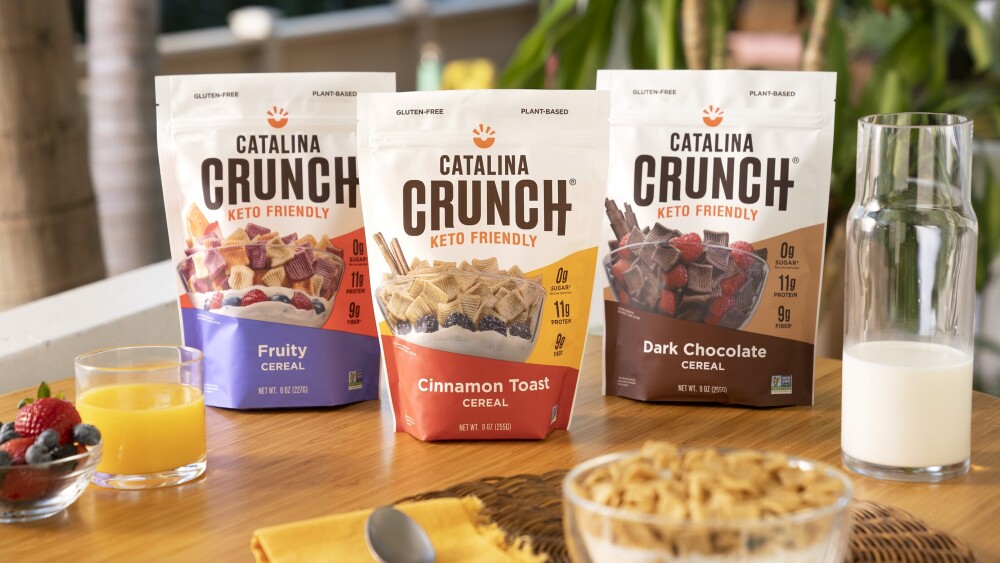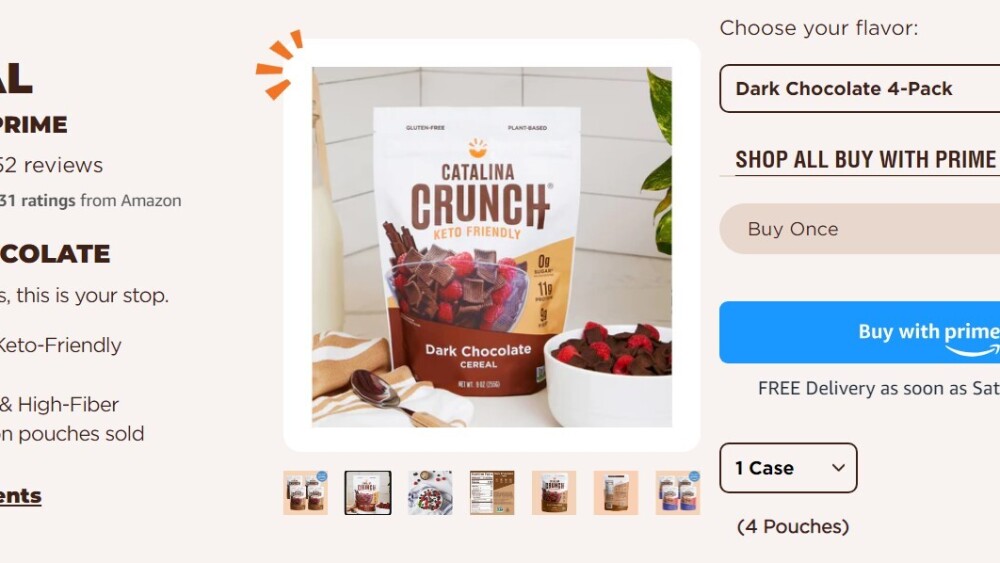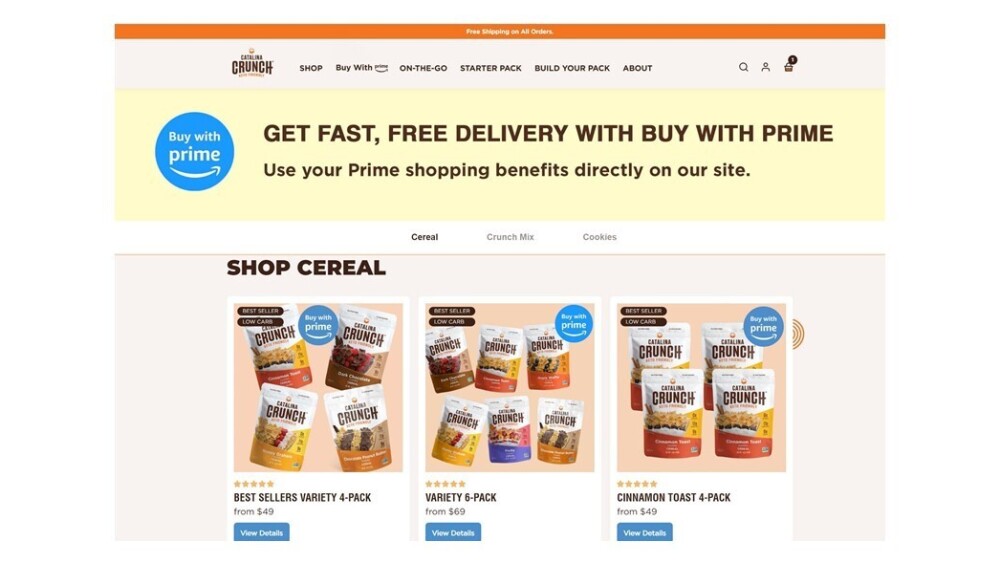When Catalina Crunch launched in 2018 as single-product, low-sugar cereal brand available only on CatalinaCrunch.com , not many people knew about it. But for founder Krishna Kaliannan, it was life-changing. As a teenager, he had been diagnosed with T1 diabetes and found himself struggling throughout adulthood to find healthy snacks that weren’t loaded with sugar and empty carbs. So he took it upon himself to create the snacks that he craved and that his body needed. He founded Catalina Crunch on the premise of “combining nutritional science with culinary arts” to create delicious, yet healthier cereals and snacks.
Nick Osborn has been along for the ride from the beginning, wearing many hats to help Krishna grow Catalina Crunch into what it is today. They initially launched with one cereal flavor sold directly to consumers on the brand’s Shopify site. But since then, the product portfolio has expanded to three categories and 16 snacks that are now available at retail outlets like Whole Foods, Target, and on Amazon.com.
“Our ecommerce site is no longer the core channel and is actually only a small percentage currently,” Nick admits. “Retail and Amazon are our biggest outlets. That was just part of the gradual expansion plan , with Amazon giving us broader reach to anyone, anywhere.”
Selling direct to consumer, again
As Head of Growth, Nick still wears a lot of hats. But now that the Catalina Crunch team has expanded along with the brand, he’s turned his focus back to the sales channel where it all started: CatalinaCrunch.com. Although Fulfillment by Amazon (FBA) handles Amazon.com orders, Catalina Crunch fulfills website orders in-house. When Nick heard about Buy with Prime as a way to convert shoppers beyond Amazon while still using Amazon’s fulfillment services, he says it “just made sense because we were already using FBA and had inventory at fulfillment centers.” It means that Amazon can fulfill Catalina Crunch’s Amazon.com orders or Buy with Prime orders from one pool of inventory.
Setting up the Buy with Prime button on the Shopify site was seamless too, he says. “I was able to do it myself. I generated the code, copied, pasted, done. It was very simple and easy.”
Because Catalina Crunch sells a lot of its snacks through subscriptions and Buy with Prime is primarily a “buy now” experience, Nick had to tweak the code for the quantity selector and got creative with how he set up the product pages. He also created a Buy with Prime collection page that’s featured in the global top navigation, which he’s currently A/B testing to see if including it there impacts shopper clicks or conversions.
Lowering acquisition costs
One of the reasons Nick was interested in trying Buy with Prime for Catalina Crunch is the credibility and trust that Amazon brings, particularly for people who are new to the brand, Nick says. “We have a lot more brand awareness now than we did five years ago, but our brand awareness is still low. When new folks who have never heard of us come to our site, they might decide that they don’t want to buy because they’re not sure. But if they see Buy with Prime, it’s a familiar name and they might be more likely to give us a try. It adds a layer of trust.”
With his focus on building the brand and driving sales on channels beyond Amazon and retail, Nick has doubled down on prospecting and marketing efforts. He was already leveraging Amazon marketing resources to boost the brand’s paid media efforts and understand how those efforts were impacting sales across different channels. With Buy with Prime, the Catalina Crunch team gains customer and order data that it can use to inform custom marketing campaigns and promotions. And Nick set up the Social Ads for Buy with Prime app to engage shoppers on Instagram and Facebook with dynamic product ads that automatically feature the Buy with Prime badge on Catalina Crunch product images.
For prospecting, his strategy is twofold: “I’m using my own creatives with the Catalina Crunch brand alongside the Buy with Prime badge, and I’m using Social Ads for Buy with Prime for remarketing to non-buyers who visited our site.”
In the short time that he’s invested in these efforts, Catalina Crunch is already seeing results. From June 1 to July 15, 2023, 48% of the orders attributed to Buy with Prime ads on Instagram were Buy with Prime orders. What’s more, customer acquisition costs (CACs) are 20% lower for Buy with Prime creatives that point to Catalina Crunch’s Buy with Prime collection page than creatives without Buy with Prime, according to Nick.
Looking to the future
When Nick set out a roadmap for Catalina Crunch and Buy with Prime, he was interested in learning a few things, specifically, if the new checkout option would help: decrease CACs, increase conversions, increase repeat purchase rates, or reduce fulfillment costs.
Using Social Ads for Buy with Prime, he’s seeing those CACs come down, but it’s still too early to draw conclusions for the other areas he’s collecting data. His roadmap is packed with both in-house experimentation and A/B testing through Buy with Prime Partner VWO. Following the launch of Buy with Prime cart , Catalina Crunch added cart building functionality for products that offer Buy with Prime, and Nick is working with VWO to A/B test the feature. It allows Prime members to add multiple Buy with Prime-eligible products to the cart and check out in one transaction, instead of a “buy now” experience. Although his ideal state would be Buy with Prime for subscriptions, cart building is a natural next step for Catalina Crunch as an ecommerce brand in a category with traditionally high units per order.
Early testing has Nick feeling optimistic about how Buy with Prime is impacting the business. For Catalina Crunch’s shoppers, he’s just happy to offer an even better shopping experience for visitors to the Shopify site as he strives to boost brand awareness and sales on the channel.
Interested to see how
Buy with Prime
can help your business streamline fulfillment or lower customer acquisition costs?
Get started today
!



